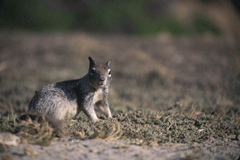Squirrel Subdivision
Air Date: Week of April 20, 2007

California ground squirrel (Spermophilus beecheyi) (Courtesy of National Biological Information Infrastructure)
An empty lot across from the local Donut & Burger in southern California is the surprising habitat of a colony of ground squirrels. Commentator Verlyn Klinkenborg muses on the squirrels’ adaptation to city living.
Transcript
CURWOOD: Few species are as adaptable to different conditions as humans. Commentator Verlyn Klinkenborg recently encountered one of them in the wilds of Los Angeles.
KLINKENBORG: It was a blank noon on one of those southern California days that is like a shallow bowl filled with almost nothing, a day when the main event turns out to have been lunch at Donut & Burger. I ate in the truck with the windows down, looking at the vacant lot next door through a chain-link fence. The view seemed to say more than I wanted to hear about the kind of day this was turning out to be.
But the grass beyond the fence parted and a head poked up. Then more heads. The vacant lot wasn’t vacant at all. It was occupied by a prosperous colony of ground squirrels, Spermophilus beecheyi, named after the English explorer Sir Frederick William Beechey, who visited California in the HMS Blossom 180 years ago. I didn’t know about Sir Frederick at the time. I knew only that these were ground squirrels and that this vacant lot was a ground-squirrel subdivision and that I had just eaten a burger and a donut for lunch in the city of Pomona, California, which is named for a minor Roman goddess of tree fruits.

California ground squirrel (Spermophilus beecheyi)(Courtesy of National Biological Information Infrastructure)
But you don’t have to read very much about Spermophilus beecheyi to realize that California ground squirrels are nearly human in their adaptability. And like all creatures, that are nearly human in their adaptability, humans consider them pests. Ground squirrels invade gardens and damage plants. They can carry bubonic plague. They destroy the eggs of ground-nesting birds. Their burrows can extend for dozens of feet. I found myself telling a new story. The ground squirrels in that vacant lot are colonists, opening new terrain to an expansionist species, developing the site before human developers can do so. Perhaps there is an archipelago of ground squirrels quietly shaping the earth to suit their needs. They watch the humans eating at Donut & Burger and know their time will come.
[MUSIC: The Album Leaf “Broken Arrow” from ‘Into The Blue Again’ (Sub Pop – 2006)]
CURWOOD: Verlyn Klinkenborg is an editorial writer for the New York Times. And is teaching writing this year at Pomona College in California.
Living on Earth wants to hear from you!
Living on Earth
62 Calef Highway, Suite 212
Lee, NH 03861
Telephone: 617-287-4121
E-mail: comments@loe.org
Newsletter [Click here]
Donate to Living on Earth!
Living on Earth is an independent media program and relies entirely on contributions from listeners and institutions supporting public service. Please donate now to preserve an independent environmental voice.
NewsletterLiving on Earth offers a weekly delivery of the show's rundown to your mailbox. Sign up for our newsletter today!
 Sailors For The Sea: Be the change you want to sea.
Sailors For The Sea: Be the change you want to sea.
 The Grantham Foundation for the Protection of the Environment: Committed to protecting and improving the health of the global environment.
The Grantham Foundation for the Protection of the Environment: Committed to protecting and improving the health of the global environment.
 Contribute to Living on Earth and receive, as our gift to you, an archival print of one of Mark Seth Lender's extraordinary wildlife photographs. Follow the link to see Mark's current collection of photographs.
Contribute to Living on Earth and receive, as our gift to you, an archival print of one of Mark Seth Lender's extraordinary wildlife photographs. Follow the link to see Mark's current collection of photographs.
 Buy a signed copy of Mark Seth Lender's book Smeagull the Seagull & support Living on Earth
Buy a signed copy of Mark Seth Lender's book Smeagull the Seagull & support Living on Earth

